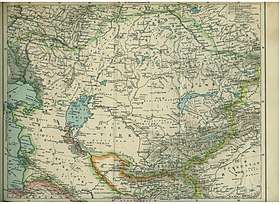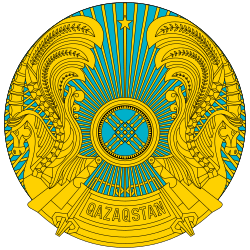Christianity in Kazakhstan
Christianity in Kazakhstan is the second most practiced religion after Islam. There are 4,214,232 Christians in Kazakhstan (according to the 2009 census).[1] The majority of Christian citizens are Russians, Ukrainians and Belarusians, who belong to the Orthodox Church in Kazakhstan under the Moscow Patriarchate. About 1.5 percent of the population is ethnically German, most of whom are Catholic or Lutheranism. There are also many Presbyterians, Jehovah's Witnesses, Seventh-day Adventists and Pentecostals.[2][3] Methodists, Mennonites, and Mormons have also registered churches with the government.[2]
| Christianity by country |
|---|
 |
|
|
|
|
Oceania
|
|
South America
|
|
|
There are more Protestant congregations - 93 "nontraditional" Protestant Christian churches registered with the Kazakh government from 2006 to 2007. There are 83 Catholic church buildings in Kazakhstan.[4] According to a 2009 national census, 26% of Kazakhstan's population is Christian.[5] There are two Baptist organizations in Kazakhstan: the Council of Churches of Evangelical Christians and Baptists, with 1,000 members, and the Baptist Union of Kazakhstan, with 10,000 members. 198 churches affiliated with the Baptist Union are registered with the government.[2]
Demographics

According to the 2009 Census, there were 4,214,232 Christians in Kazakhstan. Their ethnic affiliation is as follows:[6]
- Russians - 3,476,748 (91.6% of the ethnic Russians)
- Ukrainians - 302,199 (90.7% of Ukrainians)
- Germans - 145,556 (81.6%)
- Belarusians - 59,936 (90.2%)
- Koreans - 49,543 (49.4%)
- Kazakhs - 39,172 (0.4%)
- Polish - 30,675 (90.1%)
- Tatars - 20,913 (10.2%)
- Azeris - 2,139 (2.5%)
- Uzbeks - 1,794 (0.4%)
- Uighurs - 1,142 (0.5%)
- Chechens - 940 (3.0%)
- Tajiks - 331 (0.9%)
- Turkish - 290 (0.3%)
- Kyrgyz - 206 (0.9%)
- Kurds - 203 (0.5%)
- Dungan - 191 (0.4%)
- Other minorities - 82,254 (52.3%)
History

Before the conquest of Genghis Khan there used to be a minority of Nestorians in the Kazakh region.
By the time Kazakhstan was conquered by Genghis Khan, most of the Naimans were Christians. They remained so after the Mongol conquest and were among the second wave of Christians to enter China with Kublai Khan.[7] Meanwhile, the Naimans who settled in the Western Khanates of the Mongol Empire were all eventually converted to Islam.
Converts to Christianity
A 2015 study estimates some 50,000 Christians from a Muslim background residing in the country.[8]
See also
- Bukharan Jews
- Judaism in Kazakhstan
- Hinduism in Kazakhstan
- Islam in Kazakhstan
- Catholicism in Kazakhstan
References
- https://www.liportal.de/fileadmin/user_upload/oeffentlich/Kasachstan/40_gesellschaft/Kaz2009_Analytical_report.pdf
- International Religious Freedom Report 2008 U.S. Embassy in Astana, Kazakhstan
- Kazakhstan CIA The World Factbook
- International Religious Freedom Report 2006 Archived 22 June 2008 at the Wayback Machine U.S. Embassy in Astana, Kazakhstan
- "Итоги национальной переписи населения 2009 года (Summary of the 2009 national census)" (in Russian). Agency of Statistics of the Republic of Kazakhstan. Archived from the original on 12 June 2013. Retrieved 15 November 2010.
- "Archived copy". Archived from the original on 23 July 2011. Retrieved 24 July 2011.CS1 maint: archived copy as title (link)
- Cary-Elwes, Columba. China and the Cross. (New York: P. J. Kennedy and Sons, 1956) p. 37
- Johnstone, Patrick; Miller, Duane Alexander (2015). "Believers in Christ from a Muslim Background: A Global Census". IJRR. 11 (10): 1–19. Retrieved 30 October 2015.
